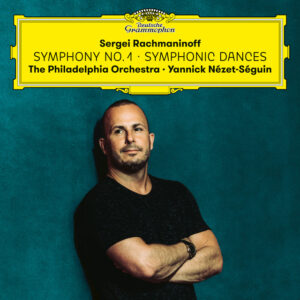GRAMOPHONE Review: Rachmaninov Symphony No. 1 / Symphonic Dances – Philadelphia Orchestra/Nézet-Séguin
 There can be no underestimating the extraordinary legacy surrounding Rachmaninov and Philadelphia. That he composed the Third Symphony and Symphonic Dances with the city’s great orchestra in mind is testament to how their sound intoxicated him. The string sound in particular played into not just the precision and opulence of his writing but more importantly its obsessiveness and inherent darkness. Among Rachmaninov cognoscenti and collectors alike the Eugene Ormandy recordings of the two pieces featured here – the beginning and end of his fabled journey – have remained pretty unassailable.
There can be no underestimating the extraordinary legacy surrounding Rachmaninov and Philadelphia. That he composed the Third Symphony and Symphonic Dances with the city’s great orchestra in mind is testament to how their sound intoxicated him. The string sound in particular played into not just the precision and opulence of his writing but more importantly its obsessiveness and inherent darkness. Among Rachmaninov cognoscenti and collectors alike the Eugene Ormandy recordings of the two pieces featured here – the beginning and end of his fabled journey – have remained pretty unassailable.
But there’s a new kid (relatively speaking) in the driving seat of this orchestra and his ability to dig into that legacy whilst renewing its startling innovation makes for an exciting newness. Indeed Nézet-Séguin’s account of the troubled First Symphony is as surprising and as thrilling as any I have heard since that much lauded Ormandy account. One starts to realise why Glazunov’s reputedly miserable first performance denied it any hope of early success. In the wrong hands the piece can sound fitful, its lyric musings in particular halting and half-formed. I am thinking especially of the second subject group in the first movement which under Nézet-Séguin truly sounds like a creation of the moment – a bar-by-bar extemporisation born of great sadness. It’s a very particular kind of melancholy that Rachmaninov projects and in the flickering sepia-tinted uncertainty of the slow movement – exquisitely realised here with every solo woodwind telling a story of its own – you start to realise how radical this piece is striving to be.
The all-pervasive four-note motif prefacing every movement like a portent of tragedy stands out in sharp relief here and the rhythmic imperative of the performance (and fabulous incisiveness of the string playing, often viola-led) papers over Rachmaninov’s obsessive dependency on fugal writing to move the narrative forward. There’s a brighter triumphalism beckoning in the familiar fanfares which kick off the finale but always this weighty undertow dragging things down. Just listen to the impetuous sweep of the second subject, the shine on the violins belying the saturating darkness beneath.
The culmination of the First Symphony’s anxiety – immediately following that defining crash of the tam-tam – comes with the huge climactic bridge into the coda where Nézet-Séguin really piles on a welter of brassy dissonance. Absolutely thrilling. All that remains is the obsessive repetition of the four-note motif and two horribly emphatic final chords which stop it in its tracks.
Rachmaninov’s final orchestral work – Symphonic Dances – looks and sounds so different on and off the page and the operative word in Nézet-Séguin’s reading is ‘Dances’. The sprung rhythms, the impetus, are again key – but beneath the surface sparkle and rhythmic buoyancy is a substrata of regret and despair. What lies beneath is a barely concealed chronicle of the composer’s trials and tribulations. The alto sax at the heart of the first dance – the 20th century’s instrument of choice for ‘the blues’ – wreaks of homesickness but its is the quotation from the First Symphony in the coda – transfigured now to become something of a warm embrace – that really hits home: a wistful last laugh catching in the throat but luminous nonetheless.
Needless to say the spectral enchantment of the central Waltz is ‘Philadelphia Central’ – where the orchestra lives and breathes. Somehow or other all the qualities of the Rachmaninov/Ormandy era have spirited their way back to create a kind of faded opulence. I absolutely love the way that in the final return of the waltz theme – beautifully managed in magical pianissimo by Nézet-Séguin and the orchestra – it can barely drag itself off the floor so heavy is its burden.
Pursued by his demons in the finale, this rush to judgement, ride to the abyss, is predictably virtuosic. But it is the keening anxieties of the middle section that one remembers. That passage where bass clarinet draws us shyly into its confidence is especially bleak, like a glimpse into Rachmaninov’s very soul.
Nézet-Séguin opts for the prolonged resonance of the tam-tam at the very close – a direct parallel with that pre-coda moment in the First Symphony. Of course, you can do this effectively without an audience present – very hard otherwise to stifle the inevitable applause. But I still have my doubts that this is what Rachmaninov really wanted. For sure the notated value of the tam-tam stroke overhangs the rest of the orchestra by a whisker – but pointedly he does not write ‘laissez vibrer’ over the final tam-tam stroke as he does pointedly a couple of bars earlier. I have to say I prefer the brutality of an abrupt cut-off.
Even so, an altogether stunning disc.
You May Also Like

A Conversation With JOSHUA BELL
02/09/2011
A Conversation With MAUREEN LIPMAN
12/10/2014

